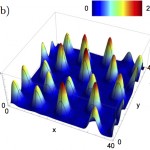
Formation of bacterial colonies:
hydrodynamic approach
Formation of bacterial colonies: hydrodynamic approach
Our paper on formation and dissolution of bacterial colonies is published
in Phys. Rev. E
by C. Weber, Y.T. Lin, N. Biais, and V. Zaburdaev

Abstract
Many organisms form colonies for a transient period of time to withstand environmental pressure. Bacterial biofilms are a prototypical example of such behavior. Despite significant interest across disciplines, physical mechanisms governing the formation and dissolution of bacterial colonies are still poorly understood. Starting from a kinetic description of motile and interacting cells we derive a hydrodynamic equation for their density on a surface, where most of the kinetic coefficients are estimated from experimental data for N. gonorrhoeae bacteria. We use it to describe the formation of multiple colonies with sizes consistent with experimental observations. Finally, we show how the changes in the cell-to-cell interactions lead to the dissolution of the bacterial colonies. The successful application of kinetic theory to a complex far from equilibrium system such as formation and dissolution of living bacterial colonies potentially paves the way for the physical quantification of the initial stages of biofilm formation.
See Publications page for the full paper.
(September 30, 2015)